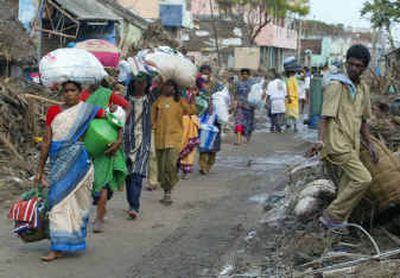Logistics problems stall aid

MEDAN, Indonesia – Two U.S. Air Force Hercules C-130 cargo airplanes – workhorses of war, calamity and humanitarian relief – were parked Saturday on the runway here, the only two such American aircraft operating in Indonesia, where hundreds of thousands of people are desperate for clean water, food and shelter in the wake of last Sunday’s earthquake and tsunami.
Inside a hangar perhaps 200 yards away, bags of rice, boxes of instant noodles and cases of bottled water were piled halfway to the rafters, waiting to be loaded onto planes en route to the worst-hit areas on the island of Sumatra.
But the American crews stood listlessly in the tropical night, frustrated by forces beyond their control. They waited for scarce loading pallets. They waited for the lone forklift used to load and unload a half-dozen relief planes from several countries. Then they waited for a crew of Indonesian soldiers to help load the supplies the only way available – by hand, box by box.
Even after the planes were finally loaded, they sat and waited some more: The runway at Banda Aceh – capital of Aceh province, hard-hit by the disaster – was at that moment crammed with seven other planes. There was no room for another. Until one left, the American crews had to sit on the ground in Medan without clearance to leave.
As the United States, other nations and private groups marshal a relief effort of about $2 billion aimed at preventing disease and hunger for victims of the catastrophe, operations are being slowed by inadequate numbers of airplanes, scarce loading facilities and poor coordination, according to relief workers, diplomats and crews engaged in the mission.
“Look at all this stuff,” said trauma expert Bertus Louw, who had just flown in with a team from the South African nongovernment emergency aid group Global Relief. “The stuff is here, but it’s not getting to people quickly enough. Definitely, people are dying.”
Louw’s team of 12 – among them doctors, divers and engineers – carried water purification systems, a key element in the effort to prevent the spread of disease. Yet after being told there was room for them on board an American plane, they were informed that the flight was full and that they would have to wait here indefinitely.
“There are definitely not enough airplanes,” said Imam Rahmadsyah, a volunteer with an Indonesian rescue-and-medical team. Beyond airlift, there are many other more daunting problems, such as how to distribute the supplies to scattered, devastated communities in which roads, electricity and communications were never good and are now in ruins.
On Wednesday, the United States convened a joint task force drawn from all branches of the U.S. military to oversee its contribution to the humanitarian airlift, establishing a headquarters at the Utapao Air Base in Thailand, a facility where U.S. B-52 bombers were based during the Vietnam War era. Officials are now employing what they describe as a wheel-and-spoke system, running cargo sorties from Utapao and Bangkok to hubs near the hardest-hit areas of Indonesia, Thailand and Sri Lanka.
By Saturday, the mission had flown nine sorties from Utapao, using six Hercules planes with another four C-130s from Bangkok and six more expected to arrive over the weekend, U.S. officials said.
The Navy was operating a fleet of 10 P-3 reconnaissance aircraft from Diego Garcia, seeking to identify runways that could be used for the airlift. In the waters near the Indonesian island of Sumatra, the aircraft carrier USS Abraham Lincoln was sending helicopters to ferry relief into areas beyond the reach of airplanes.
In an interview Saturday in Utapao, the commander of the U.S. Air Force complement of the task force, Col. Rod Gregory, said he was satisfied with the progress of the mission. “Given the limited amount of time that things have been going on, I would characterize it as outstanding,” Gregory said. “Everything we need is on the way and we’re going to continue building up our capability.”